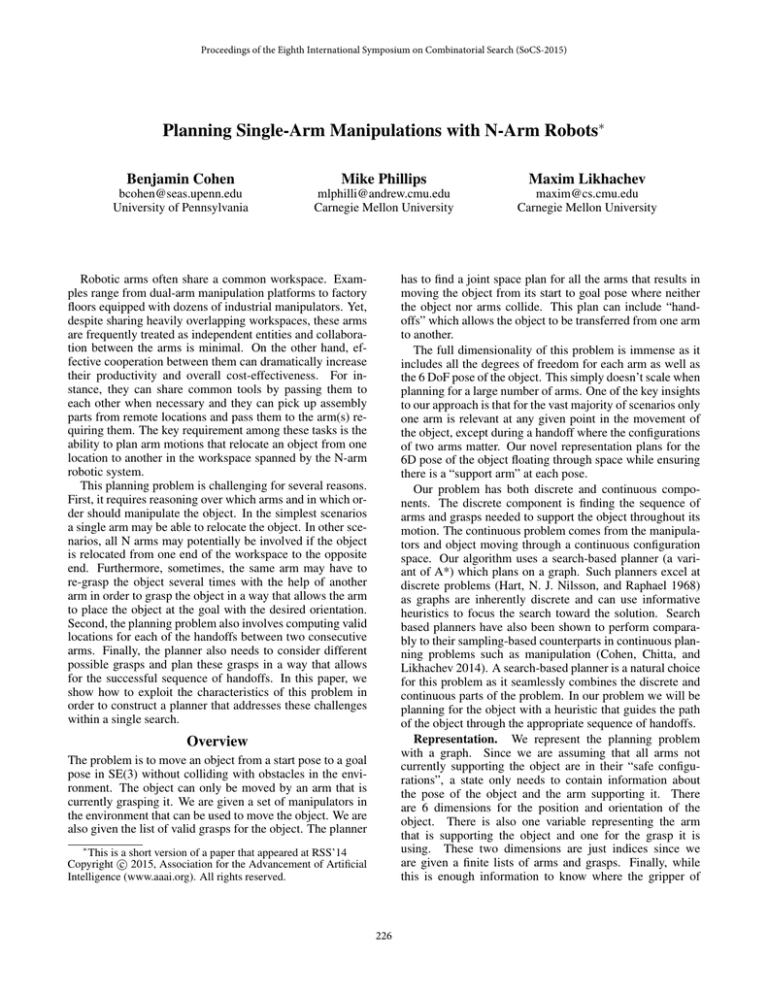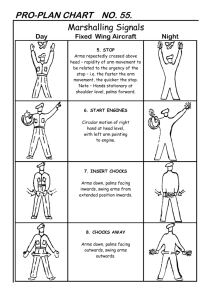
Proceedings of the Eighth International Symposium on Combinatorial Search (SoCS-2015)
Planning Single-Arm Manipulations with N-Arm Robots∗
Benjamin Cohen
Mike Phillips
Maxim Likhachev
bcohen@seas.upenn.edu
University of Pennsylvania
mlphilli@andrew.cmu.edu
Carnegie Mellon University
maxim@cs.cmu.edu
Carnegie Mellon University
Robotic arms often share a common workspace. Examples range from dual-arm manipulation platforms to factory
floors equipped with dozens of industrial manipulators. Yet,
despite sharing heavily overlapping workspaces, these arms
are frequently treated as independent entities and collaboration between the arms is minimal. On the other hand, effective cooperation between them can dramatically increase
their productivity and overall cost-effectiveness. For instance, they can share common tools by passing them to
each other when necessary and they can pick up assembly
parts from remote locations and pass them to the arm(s) requiring them. The key requirement among these tasks is the
ability to plan arm motions that relocate an object from one
location to another in the workspace spanned by the N-arm
robotic system.
This planning problem is challenging for several reasons.
First, it requires reasoning over which arms and in which order should manipulate the object. In the simplest scenarios
a single arm may be able to relocate the object. In other scenarios, all N arms may potentially be involved if the object
is relocated from one end of the workspace to the opposite
end. Furthermore, sometimes, the same arm may have to
re-grasp the object several times with the help of another
arm in order to grasp the object in a way that allows the arm
to place the object at the goal with the desired orientation.
Second, the planning problem also involves computing valid
locations for each of the handoffs between two consecutive
arms. Finally, the planner also needs to consider different
possible grasps and plan these grasps in a way that allows
for the successful sequence of handoffs. In this paper, we
show how to exploit the characteristics of this problem in
order to construct a planner that addresses these challenges
within a single search.
has to find a joint space plan for all the arms that results in
moving the object from its start to goal pose where neither
the object nor arms collide. This plan can include “handoffs” which allows the object to be transferred from one arm
to another.
The full dimensionality of this problem is immense as it
includes all the degrees of freedom for each arm as well as
the 6 DoF pose of the object. This simply doesn’t scale when
planning for a large number of arms. One of the key insights
to our approach is that for the vast majority of scenarios only
one arm is relevant at any given point in the movement of
the object, except during a handoff where the configurations
of two arms matter. Our novel representation plans for the
6D pose of the object floating through space while ensuring
there is a “support arm” at each pose.
Our problem has both discrete and continuous components. The discrete component is finding the sequence of
arms and grasps needed to support the object throughout its
motion. The continuous problem comes from the manipulators and object moving through a continuous configuration
space. Our algorithm uses a search-based planner (a variant of A*) which plans on a graph. Such planners excel at
discrete problems (Hart, N. J. Nilsson, and Raphael 1968)
as graphs are inherently discrete and can use informative
heuristics to focus the search toward the solution. Search
based planners have also been shown to perform comparably to their sampling-based counterparts in continuous planning problems such as manipulation (Cohen, Chitta, and
Likhachev 2014). A search-based planner is a natural choice
for this problem as it seamlessly combines the discrete and
continuous parts of the problem. In our problem we will be
planning for the object with a heuristic that guides the path
of the object through the appropriate sequence of handoffs.
Representation. We represent the planning problem
with a graph. Since we are assuming that all arms not
currently supporting the object are in their “safe configurations”, a state only needs to contain information about
the pose of the object and the arm supporting it. There
are 6 dimensions for the position and orientation of the
object. There is also one variable representing the arm
that is supporting the object and one for the grasp it is
using. These two dimensions are just indices since we
are given a finite lists of arms and grasps. Finally, while
this is enough information to know where the gripper of
Overview
The problem is to move an object from a start pose to a goal
pose in SE(3) without colliding with obstacles in the environment. The object can only be moved by an arm that is
currently grasping it. We are given a set of manipulators in
the environment that can be used to move the object. We are
also given the list of valid grasps for the object. The planner
∗
This is a short version of a paper that appeared at RSS’14
c 2015, Association for the Advancement of Artificial
Copyright Intelligence (www.aaai.org). All rights reserved.
226
the supporting manipulator is, for many manipulators this
doesn’t map to a single set of joint angles. There are often
many solutions for a particular end-effector pose. These
manipulators can have this redundancy captured by a set of
“free angles”, denoted below as φ0 , . . . , φm . For example,
in our experiments we use PR2 arms which have 7 degrees
of freedom. An end-effector pose can be mapped to a
set of joint angles given one free angle (in this case the
upper arm roll joint). Formally a state vector is defined as:
{xobj , yobj , zobj , rollobj , pitchobj , yawobj , armid , graspid ,
φ0 , . . . , φm }.
Motion primitives are actions that can be applied at any
state in the graph to transition to neighboring states. There
are motions for modifying the object position and orientation state variables by small amounts. There are also motion
primitives for changing the support arm free angles. All of
these motions are computed by running inverse kinematics
with the new object pose or free angle.
The last kind of motion primitive is to switch supports.
To do this a newly selected arm must move from its safe
configuration to the newly selected grasp and then the previous support arm has to move back to its safe configuration.
These motions can be quite complicated so we call an arm
planner for a short period of time to check for feasibility.
The planner we chose to use is also a search-based motion
planner (Cohen, Chitta, and Likhachev 2014). Evaluating
this edge can be expensive.
Search. When planning in high-dimensional problems
the graph is too large to compute up front and is instead generated as the search progresses. One of the characteristics of
our problem is that some edges in our graph are far more
expensive to evaluate than others. In particular, determining if the object can switch support arms requires two calls
to a single-arm path planner. Additionally, most states have
the option to transition to more than one arm for several different grasps, which is a computationally expensive edge to
evaluate. We use a lazy version of Weighted A* (Pohl 1970)
search, which fully evaluates edges only when the planner
intends to use them, drastically reducing a potentially large
waste of computation time.
Heuristic. Our heuristic is the sum of two components:
guiding the object toward the goal and encouraging the most
promising handoffs.
In order to guide the search toward the goal, we run a
reverse Dijkstra search for the 3D location of the object
backward from the goal to all (x,y,z) cells in the environment while accounting for obstacles. We call this a “Point
Search”. This approximates the distance from all positions
in the world to the goal location. In order to capture some
of the orientation information of the goal pose, we actually
run several of these Point Searches for different points on
the object.
The second component of the heuristic is a handoff
penalty. We approximate the number of remaining handoffs
needed to get the object at the goal pose. This approximation
is formulated as a dynamic programming problem. It computes the minimum number of handoffs required to get to
the goal assuming that the object is being held by arm with
grasp. This heuristic discourages using unneeded handoffs,
tabletop (2-arm, tray)
bar (3-arm, tray)
checkout (3-arm, tray)
factory (4-arm, rod)
success
rate
mean
time(s)
max
time(s)
mean
expands
mean
handoffs
100
50
100
100
10.25
16.93
9.67
36.09
36.52
39.93
16.22
78.41
226
857
220
2239
1.33
2
1.8
1.8
Table 1: Performance of the planner in four different scenes.
encourages needed handoffs and helps the planner choose
the right grasps for the handoff. Details of the heuristic computation and how we ensured it is admissable are discussed
in (Cohen, Phillips, and Likhachev 2014).
Experimental Results
To measure the performance of the planner, we generated a
set of four realistic scenes in which we strategically placed
between two and four arms such that almost all areas of interest can be reached by at least one. The manipulators used
are the 7 DoF arms of the PR2 robot. The position of only
a single redundant joint has to be recorded in the state representation, resulting in a total of nine dimensions. The four
scenarios include a PR2(with two arms) infront of a cluttered tabletop, three arms working behind a bar, three arms
at a self-checkout counter and four arms configured around
a car chassis on an assembly line in a factory. The planning
problems in each scenario were created by hand to assure
that each one requires at least one handoff and is challenging
either because of obstacles, kinematic constraints or restrictive start and goal poses. The planner is given a maximum
of 100 seconds to compute a solution.
Results from the 25 trials can be seen in Table 1. Overall, the average planning time is 18.2 seconds and the planner was successful in planning in 20 of 25 total trials, for
a total success rate of 80%. In particular, we found that in
most of the trials the minimum number of handoffs required
were performed but not in all of them. Additionally, we were
pleased to see that the planner successfully determined that
because of the initial object pose, a series of back and forth
handoffs were needed between the arm used to put the object down and the arm that transferred the object to it, so that
the final grasp was capable of achieving the goal pose.
References
Cohen, B. J.; Chitta, S.; and Likhachev, M. 2014. Singleand dual-arm motion planning with heuristic search. The
International Journal of Robotics Research 33(2):305–320.
Cohen, B.; Phillips, M.; and Likhachev, M. 2014. Planning
single-arm manipulations with n-arm robots. In Robotics
Science and Systems (RSS).
Hart, P. E.; N. J. Nilsson; and Raphael, B. 1968. A formal basis for the heuristic determination of minimum cost
paths. IEEE Transactions on Systems, Science, and Cybernetics SSC-4(2):100–107.
Pohl, I. 1970. First results on the effect of error in heuristic
search. Machine Intelligence 5:219–236.
227



